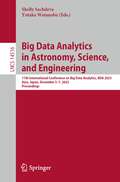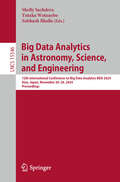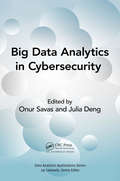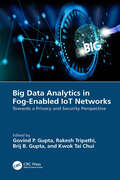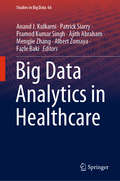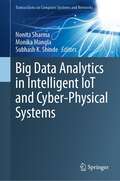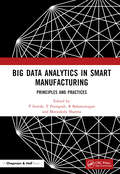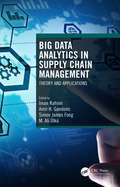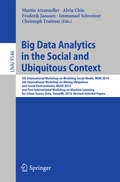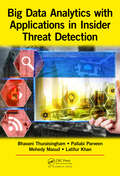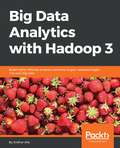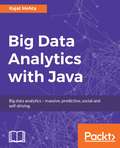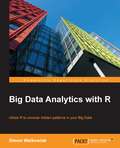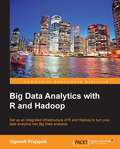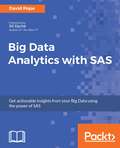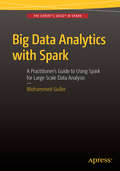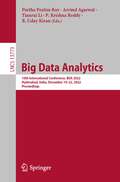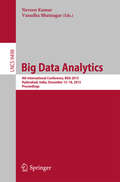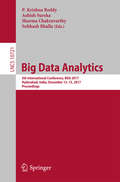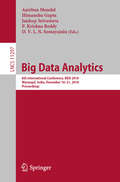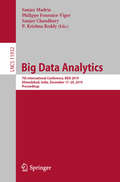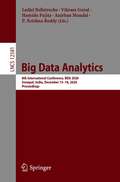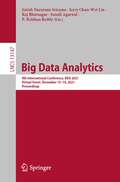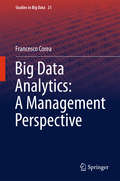- Table View
- List View
Big Data Analytics in Astronomy, Science, and Engineering: 11th International Conference on Big Data Analytics, BDA 2023, Aizu, Japan, December 5–7, 2023, Proceedings (Lecture Notes in Computer Science #14516)
by Shelly Sachdeva Yutaka WatanobeThis book constitutes the proceedings of the 11th International Conference on Big Data Analytics in Astronomy, Science, and Engineering, BDA 2023, which took place in Aizu, Japan during December 5–7, 2023. The 19 full papers included in this book were carefully reviewed and selected from 55 submissions. They were organized in topical sections as follows: Data management and visualization; data science: architectures and systems; data science and applications; and cyber systems and information security.
Big Data Analytics in Astronomy, Science, and Engineering: 12th International Conference on Big Data Analytics, BDA 2024, Aizu, Japan, November 26–28, 2024, Proceedings (Lecture Notes in Computer Science #15546)
by Subhash Bhalla Shelly Sachdeva Yutaka WatanobeThis book constitutes the proceedings of the 12th International Conference on Big Data Analytics in Astronomy, Science, and Engineering, BDA 2024, which took place in Aizu, Japan during November 26-28, 2024. The 16 full papers included in this book were carefully reviewed and selected from 90 submissions; the proceedings also include 6 invited papers. The contributions were organized in topical sections as follows: Big Data: analysis and management; data science; big data applications; and information security.
Big Data Analytics in Cybersecurity (Data Analytics Applications)
by Onur Savas Julia DengBig data is presenting challenges to cybersecurity. For an example, the Internet of Things (IoT) will reportedly soon generate a staggering 400 zettabytes (ZB) of data a year. Self-driving cars are predicted to churn out 4000 GB of data per hour of driving. Big data analytics, as an emerging analytical technology, offers the capability to collect, store, process, and visualize these vast amounts of data. Big Data Analytics in Cybersecurity examines security challenges surrounding big data and provides actionable insights that can be used to improve the current practices of network operators and administrators. Applying big data analytics in cybersecurity is critical. By exploiting data from the networks and computers, analysts can discover useful network information from data. Decision makers can make more informative decisions by using this analysis, including what actions need to be performed, and improvement recommendations to policies, guidelines, procedures, tools, and other aspects of the network processes. Bringing together experts from academia, government laboratories, and industry, the book provides insight to both new and more experienced security professionals, as well as data analytics professionals who have varying levels of cybersecurity expertise. It covers a wide range of topics in cybersecurity, which include: Network forensics Threat analysis Vulnerability assessment Visualization Cyber training. In addition, emerging security domains such as the IoT, cloud computing, fog computing, mobile computing, and cyber-social networks are examined. The book first focuses on how big data analytics can be used in different aspects of cybersecurity including network forensics, root-cause analysis, and security training. Next it discusses big data challenges and solutions in such emerging cybersecurity domains as fog computing, IoT, and mobile app security. The book concludes by presenting the tools and datasets for future cybersecurity research.
Big Data Analytics in Fog-Enabled IoT Networks: Towards a Privacy and Security Perspective
by Brij B. Gupta Rakesh Tripathi Govind P. Gupta Kwok Tai ChuiThe integration of fog computing with the resource-limited Internet of Things (IoT) network formulates the concept of the fog-enabled IoT system. Due to a large number of IoT devices, the IoT is a main source of Big Data. A large volume of sensing data is generated by IoT systems such as smart cities and smart-grid applications. A fundamental research issue is how to provide a fast and efficient data analytics solution for fog-enabled IoT systems. Big Data Analytics in Fog-Enabled IoT Networks: Towards a Privacy and Security Perspective focuses on Big Data analytics in a fog-enabled-IoT system and provides a comprehensive collection of chapters that touch on different issues related to healthcare systems, cyber-threat detection, malware detection, and the security and privacy of IoT Big Data and IoT networks. This book also emphasizes and facilitates a greater understanding of various security and privacy approaches using advanced artificial intelligence and Big Data technologies such as machine and deep learning, federated learning, blockchain, and edge computing, as well as the countermeasures to overcome the vulnerabilities of the fog-enabled IoT system.
Big Data Analytics in Healthcare (Studies in Big Data #66)
by Ajith Abraham Patrick Siarry Albert Zomaya Anand J. Kulkarni Mengjie Zhang Pramod Kumar Singh Fazle BakiThis book includes state-of-the-art discussions on various issues and aspects of the implementation, testing, validation, and application of big data in the context of healthcare. The concept of big data is revolutionary, both from a technological and societal well-being standpoint. This book provides a comprehensive reference guide for engineers, scientists, and students studying/involved in the development of big data tools in the areas of healthcare and medicine. It also features a multifaceted and state-of-the-art literature review on healthcare data, its modalities, complexities, and methodologies, along with mathematical formulations. The book is divided into two main sections, the first of which discusses the challenges and opportunities associated with the implementation of big data in the healthcare sector. In turn, the second addresses the mathematical modeling of healthcare problems, as well as current and potential future big data applications and platforms.
Big Data Analytics in Intelligent IoT and Cyber-Physical Systems (Transactions on Computer Systems and Networks)
by Monika Mangla Nonita Sharma Subhash K. ShindeThis book explores the complete system perspective, underlying theories, modeling, and applications of cyber-physical systems (CPS). Considering the interest of researchers and academicians, the editors present this book in a multidimensional perspective covering CPS at breadth. It covers topics ranging from discussion of rudiments of the system and efficient management to recent research challenges and issues. This book is divided into four sections discussing the fundamentals of CPS, engineering-based solutions, its applications, and advanced research challenges. The contents highlight the concept map of CPS including the latest technological interventions, issues, challenges, and the integration of CPS with IoT and big data analytics, modeling solutions, distributed management, efficient energy management, cyber-physical systems research, and education with applications in industrial, agriculture, and medical domains. This book is of immense interest to those in academia and industry.
Big Data Analytics in Smart Manufacturing: Principles and Practices
by T Poongodi Meenakshi Sharma P Suresh B BalamuruganThe significant objective of this edited book is to bridge the gap between smartmanufacturing and big data by exploring the challenges and limitations. Companiesemploy big data technology in the manufacturing field to acquire data about the products.Manufacturing companies could gain a deep business insight by tracking customer details,monitoring fuel consumption, detecting product defects, and supply chain management.Moreover, the convergence of smart manufacturing and big data analytics currently suffersdue to data privacy concern, short of qualified personnel, inadequate investment, long-termstorage management of high-quality data. The technological advancement makes the datastorage more accessible, cheaper and the convergence of these technologies seems to bemore promising in the recent era. This book identified the innovative challenges in theindustrial domains by integrating heterogeneous data sources such as structured data,semi-structures data, geo-spatial data, textual information, multimedia data, socialnetworking data, etc. It promotes data-driven business modelling processes by adoptingbig data technologies in the manufacturing industry. Big data analytics is emerging as apromising discipline in the manufacturing industry to build the rigid industrial dataplatforms. Moreover, big data facilitates process automation in the complete lifecycle ofproduct design and tracking. This book is an essential guide and reference since itsynthesizes interdisciplinary theoretical concepts, definitions, and models, involved insmart manufacturing domain. It also provides real-world scenarios and applications,making it accessible to a wider interdisciplinary audience. Features The readers will get an overview about the smart manufacturing system which enables optimized manufacturing processes and benefits the users by increasing overall profit. The researchers will get insight about how the big data technology leverages in finding new associations, factors and patterns through data stream observations in real time smart manufacturing systems. The industrialist can get an overview about the detection of defects in design, rapid response to market, innovative products to meet the customer requirement which can benefit their per capita income in better way. Discusses technical viewpoints, concepts, theories, and underlying assumptions that are used in smart manufacturing. Information delivered in a user-friendly manner for students, researchers, industrial experts, and business innovators, as well as for professionals and practitioners.
Big Data Analytics in Supply Chain Management: Theory and Applications
by Iman Rahimi, Amir H. Gandomi, Simon James Fong, and M. Ali ÜlküIn a world of soaring digitization, social media, financial transactions, and production and logistics processes constantly produce massive data. Employing analytical tools to extract insights and foresights from data improves the quality, speed, and reliability of solutions to highly intertwined issues faced in supply chain operations.From procurement in Industry 4.0 to sustainable consumption behavior to curriculum development for data scientists, this book offers a wide array of techniques and theories of Big Data Analytics applied to Supply Chain Management. It offers a comprehensive overview and forms a new synthesis by bringing together seemingly divergent fields of research. Intended for Engineering and Business students, scholars, and professionals, this book is a collection of state-of-the-art research and best practices to spur discussion about and extend the cumulant knowledge of emerging supply chain problems.
Big Data Analytics in the Social and Ubiquitous Context: 5th International Workshop on Modeling Social Media, MSM 2014, 5th International Workshop on Mining Ubiquitous and Social Environments, MUSE 2014, and First International Workshop on Machine Learning for Urban Sensor Data, SenseML 2014, Revised Selected Papers (Lecture Notes in Computer Science #9546)
by Martin Atzmueller Alvin Chin Christoph Trattner Frederik Janssen Immanuel SchweizerThe 9 papers presented in this book arerevised and significantly extended versions of papers submitted to threerelated workshops: The 5th International Workshop on Mining Ubiquitous and Social Environments, MUSE2014, and the First International Workshop on Machine Learning for Urban SensorData, SenseML 2014, which were held on September 15, 2014, in conjunction withthe European Conference on Machine Learning and Principles and Practice ofKnowledge Discovery in Databases (ECML-PKDD 2014) in Nancy, France; and the 5thInternational Workshop on Modeling Social Media (MSM 2014) that was held onApril 8, 2014 in conjunction with ACM WWW in Seoul, Korea.
Big Data Analytics with Applications in Insider Threat Detection
by Latifur Khan Bhavani Thuraisingham Pallabi Parveen Mohammad Mehedy MasudToday's malware mutates randomly to avoid detection, but reactively adaptive malware is more intelligent, learning and adapting to new computer defenses on the fly. Using the same algorithms that antivirus software uses to detect viruses, reactively adaptive malware deploys those algorithms to outwit antivirus defenses and to go undetected. This book provides details of the tools, the types of malware the tools will detect, implementation of the tools in a cloud computing framework and the applications for insider threat detection.
Big Data Analytics with Hadoop 3: Build highly effective analytics solutions to gain valuable insight into your big data
by Sridhar AllaExplore big data concepts, platforms, analytics, and their applications using the power of Hadoop 3Key FeaturesLearn Hadoop 3 to build effective big data analytics solutions on-premise and on cloudIntegrate Hadoop with other big data tools such as R, Python, Apache Spark, and Apache FlinkExploit big data using Hadoop 3 with real-world examplesBook DescriptionApache Hadoop is the most popular platform for big data processing, and can be combined with a host of other big data tools to build powerful analytics solutions. Big Data Analytics with Hadoop 3 shows you how to do just that, by providing insights into the software as well as its benefits with the help of practical examples.Once you have taken a tour of Hadoop 3’s latest features, you will get an overview of HDFS, MapReduce, and YARN, and how they enable faster, more efficient big data processing. You will then move on to learning how to integrate Hadoop with the open source tools, such as Python and R, to analyze and visualize data and perform statistical computing on big data. As you get acquainted with all this, you will explore how to use Hadoop 3 with Apache Spark and Apache Flink for real-time data analytics and stream processing. In addition to this, you will understand how to use Hadoop to build analytics solutions on the cloud and an end-to-end pipeline to perform big data analysis using practical use cases.By the end of this book, you will be well-versed with the analytical capabilities of the Hadoop ecosystem. You will be able to build powerful solutions to perform big data analytics and get insight effortlessly.What you will learnExplore the new features of Hadoop 3 along with HDFS, YARN, and MapReduceGet well-versed with the analytical capabilities of Hadoop ecosystem using practical examplesIntegrate Hadoop with R and Python for more efficient big data processing Learn to use Hadoop with Apache Spark and Apache Flink for real-time data analyticsSet up a Hadoop cluster on AWS cloudPerform big data analytics on AWS using Elastic Map ReduceWho this book is forBig Data Analytics with Hadoop 3 is for you if you are looking to build high-performance analytics solutions for your enterprise or business using Hadoop 3’s powerful features, or you’re new to big data analytics. A basic understanding of the Java programming language is required.
Big Data Analytics with Java
by Rajat MehtaLearn the basics of analytics on big data using Java, machine learning and other big data tools About This Book • Acquire real-world set of tools for building enterprise level data science applications • Surpasses the barrier of other languages in data science and learn create useful object-oriented codes • Extensive use of Java compliant big data tools like apache spark, Hadoop, etc. Who This Book Is For This book is for Java developers who are looking to perform data analysis in production environment. Those who wish to implement data analysis in their Big data applications will find this book helpful. What You Will Learn • Start from simple analytic tasks on big data • Get into more complex tasks with predictive analytics on big data using machine learning • Learn real time analytic tasks • Understand the concepts with examples and case studies • Prepare and refine data for analysis • Create charts in order to understand the data • See various real-world datasets In Detail This book covers case studies such as sentiment analysis on a tweet dataset, recommendations on a movielens dataset, customer segmentation on an ecommerce dataset, and graph analysis on actual flights dataset. This book is an end-to-end guide to implement analytics on big data with Java. Java is the de facto language for major big data environments, including Hadoop. This book will teach you how to perform analytics on big data with production-friendly Java. This book basically divided into two sections. The first part is an introduction that will help the readers get acquainted with big data environments, whereas the second part will contain a hardcore discussion on all the concepts in analytics on big data. It will take you from data analysis and data visualization to the core concepts and advantages of machine learning, real-life usage of regression and classification using Naive Bayes, a deep discussion on the concepts of clustering,and a review of simple neural networks on big data using deepLearning4j or plain Java Spark code. This book is a must-have book for Java developers who want to start learning big data analytics and want to use it in the real world. Style and approach The approach of book is to deliver practical learning modules in manageable content. Each chapter is a self-contained unit of a concept in big data analytics. Book will step by step builds the competency in the area of big data analytics. Examples using real world case studies to give ideas of real applications and how to use the techniques mentioned. The examples and case studies will be shown using both theory and code.
Big Data Analytics with R
by Simon WalkowiakUtilize R to uncover hidden patterns in your Big Data About This Book * Perform computational analyses on Big Data to generate meaningful results * Get a practical knowledge of R programming language while working on Big Data platforms like Hadoop, Spark, H2O and SQL/NoSQL databases, * Explore fast, streaming, and scalable data analysis with the most cutting-edge technologies in the market Who This Book Is For This book is intended for Data Analysts, Scientists, Data Engineers, Statisticians, Researchers, who want to integrate R with their current or future Big Data workflows. It is assumed that readers have some experience in data analysis and understanding of data management and algorithmic processing of large quantities of data, however they may lack specific skills related to R. What You Will Learn * Learn about current state of Big Data processing using R programming language and its powerful statistical capabilities * Deploy Big Data analytics platforms with selected Big Data tools supported by R in a cost-effective and time-saving manner * Apply the R language to real-world Big Data problems on a multi-node Hadoop cluster, e.g. electricity consumption across various socio-demographic indicators and bike share scheme usage * Explore the compatibility of R with Hadoop, Spark, SQL and NoSQL databases, and H2O platform In Detail Big Data analytics is the process of examining large and complex data sets that often exceed the computational capabilities. R is a leading programming language of data science, consisting of powerful functions to tackle all problems related to Big Data processing. The book will begin with a brief introduction to the Big Data world and its current industry standards. With introduction to the R language and presenting its development, structure, applications in real world, and its shortcomings. Book will progress towards revision of major R functions for data management and transformations. Readers will be introduce to Cloud based Big Data solutions (e.g. Amazon EC2 instances and Amazon RDS, Microsoft Azure and its HDInsight clusters) and also provide guidance on R connectivity with relational and non-relational databases such as MongoDB and HBase etc. It will further expand to include Big Data tools such as Apache Hadoop ecosystem, HDFS and MapReduce frameworks. Also other R compatible tools such as Apache Spark, its machine learning library Spark MLlib, as well as H2O. Style and approach This book will serve as a practical guide to tackling Big Data problems using R programming language and its statistical environment. Each section of the book will present you with concise and easy-to-follow steps on how to process, transform and analyse large data sets.
Big Data Analytics with R and Hadoop
by Vignesh PrajapatiBig Data Analytics with R and Hadoop is a tutorial style book that focuses on all the powerful big data tasks that can be achieved by integrating R and Hadoop.This book is ideal for R developers who are looking for a way to perform big data analytics with Hadoop. This book is also aimed at those who know Hadoop and want to build some intelligent applications over Big data with R packages. It would be helpful if readers have basic knowledge of R.
Big Data Analytics with SAS
by David PopeLeverage the capabilities of SAS to process and analyze Big Data About This Book • Combine SAS with platforms such as Hadoop, SAP HANA, and Cloud Foundry-based platforms for effecient Big Data analytics • Learn how to use the web browser-based SAS Studio and iPython Jupyter Notebook interfaces with SAS • Practical, real-world examples on predictive modeling, forecasting, optimizing and reporting your Big Data analysis with SAS Who This Book Is For SAS professionals and data analysts who wish to perform analytics on Big Data using SAS to gain actionable insights will find this book to be very useful. If you are a data science professional looking to perform large-scale analytics with SAS, this book will also help you. A basic understanding of SAS will be helpful, but is not mandatory. What You Will Learn • Configure a free version of SAS in order do hands-on exercises dealing with data management, analysis, and reporting. • Understand the basic concepts of the SAS language which consists of the data step (for data preparation) and procedures (or PROCs) for analysis. • Make use of the web browser based SAS Studio and iPython Jupyter Notebook interfaces for coding in the SAS, DS2, and FedSQL programming languages. • Understand how the DS2 programming language plays an important role in Big Data preparation and analysis using SAS • Integrate and work efficiently with Big Data platforms like Hadoop, SAP HANA, and cloud foundry based systems. In Detail SAS has been recognized by Money Magazine and Payscale as one of the top business skills to learn in order to advance one's career. Through innovative data management, analytics, and business intelligence software and services, SAS helps customers solve their business problems by allowing them to make better decisions faster. This book introduces the reader to the SAS and how they can use SAS to perform efficient analysis on any size data, including Big Data. The reader will learn how to prepare data for analysis, perform predictive, forecasting, and optimization analysis and then deploy or report on the results of these analyses. While performing the coding examples within this book the reader will learn how to use the web browser based SAS Studio and iPython Jupyter Notebook interfaces for working with SAS. Finally, the reader will learn how SAS's architecture is engineered and designed to scale up and/or out and be combined with the open source offerings such as Hadoop, Python, and R. By the end of this book, you will be able to clearly understand how you can efficiently analyze Big Data using SAS. Style and approach The book starts off by introducing the reader to SAS and the SAS programming language which provides data management, analytical, and reporting capabilities. Most chapters include hands on examples which highlights how SAS provides The Power to Know©. The reader will learn that if they are looking to perform large-scale data analysis that SAS provides an open platform engineered and designed to scale both up and out which allows the power of SAS to combine with open source offerings such as Hadoop, Python, and R.
Big Data Analytics with Spark: A Practitioner's Guide to Using Spark for Large Scale Data Analysis
by Mohammed GullerThis book is a step-by-step guide for learning how to use Spark for different types of big-data analytics projects, including batch, interactive, graph, and stream data analysis as well as machine learning. It covers Spark core and its add-on libraries, including Spark SQL, Spark Streaming, GraphX, MLlib, and Spark ML. Big Data Analytics with Spark shows you how to use Spark and leverage its easy-to-use features to increase your productivity. You learn to perform fast data analysis using its in-memory caching and advanced execution engine, employ in-memory computing capabilities for building high-performance machine learning and low-latency interactive analytics applications, and much more. Moreover, the book shows you how to use Spark as a single integrated platform for a variety of data processing tasks, including ETL pipelines, BI, live data stream processing, graph analytics, and machine learning. The book also includes a chapter on Scala, the hottest functional programming language, and the language that underlies Spark. You'll learn the basics of functional programming in Scala, so that you can write Spark applications in it. What's more, Big Data Analytics with Spark provides an introduction to other big data technologies that are commonly used along with Spark, such as HDFS, Avro, Parquet, Kafka, Cassandra, HBase, Mesos, and so on. It also provides an introduction to machine learning and graph concepts. So the book is self-sufficient; all the technologies that you need to know to use Spark are covered. The only thing that you are expected to have is some programming knowledge in any language. What you'll learn Write Spark applications in Scala for processing and analyzing large-scale data Interactively analyze large-scale data with Spark SQL using just SQL and HiveQL Process high-velocity stream data with Spark Streaming Develop machine learning applications with MLlib and Spark ML Analyze graph-oriented data and implement graph algorithms with GraphX Deploy Spark with the Standalone cluster manger, YARN, or Mesos Monitor Spark applications Who this book is for Big Data Analytics with Spark is for data scientists, business analysts, data architects, and data analysts looking for a better and faster tool for large-scale data analysis. It is also for software engineers and developers building Big Data products. Table of Contents 1. Big Data Technology Landscape 2. Programming in Scala 3. Spark Core 4. Interactive Data Analysis with Spark Shell 5. Writing a Spark Application 6. Spark Streaming 7. Spark SQL 8. Machine Learning with Spark 9. Graph Processing with Spark 10. Cluster Managers 11. Monitoring
Big Data Analytics: 10th International Conference, BDA 2022, Hyderabad, India, December 19–22, 2022, Proceedings (Lecture Notes in Computer Science #13773)
by Arvind Agarwal Tianrui Li Partha Pratim Roy P. Krishna Reddy R. Uday KiranThis book constitutes the proceedings of the 10th International Conference on Big Data Analytics, BDA 2022, which took place in Hyderabad, India, in December 2022.The 7 full papers and 7 short papers presented in this volume were carefully reviewed and selected from 36 submissions. The book also contains 4 keynote talks in full-paper length. The papers are organized in the following topical sections: Big Data Analytics: Vision and Perspectives; Data Science: Architectures; Data Science: Applications; Graph Analytics; Pattern Mining; Predictive Analytics in Agriculture.
Big Data Analytics: 4th International Conference, BDA 2015, Hyderabad, India, December 15-18, 2015, Proceedings (Lecture Notes in Computer Science #9498)
by Naveen Kumar Vasudha BhatnagarThis book constitutes the refereedconference proceedings of the Fourth International Conference on Big DataAnalytics, BDA 2015, held in Hyderabad, India, in December 2015. The 9 revised full papers and 9invited papers were carefully reviewed and selected from 61 submissions andcover topics on big data: security and privacy; big data in commerce; big data:models and algorithms; and big data in medicine.
Big Data Analytics: 5th International Conference, BDA 2017, Hyderabad, India, December 12-15, 2017, Proceedings (Lecture Notes in Computer Science #10721)
by P. Krishna Reddy, Ashish Sureka, Sharma Chakravarthy and Subhash BhallaThis book constitutes the refereed conference proceedings of the 5th International Conference on Big Data Analytics, BDA 2017, held in Hyderabad, India, in December 2017. The 21 revised full papers were carefully reviewed and selected from 80 submissions and cover topics on big data analytics, information and knowledge management, mining of massive datasets, computational modeling, data mining and analysis.
Big Data Analytics: 6th International Conference, BDA 2018, Warangal, India, December 18–21, 2018, Proceedings (Lecture Notes in Computer Science #11297)
by Jaideep Srivastava P. Krishna Reddy Anirban Mondal Himanshu Gupta D. V. L. N. SomayajuluThis book constitutes the refereed proceedings of the 6th International Conference on Big Data analytics, BDA 2018, held in Warangal, India, in December 2018. The 29 papers presented in this volume were carefully reviewed and selected from 93 submissions. The papers are organized in topical sections named: big data analytics: vision and perspectives; financial data analytics and data streams; web and social media data; big data systems and frameworks; predictive analytics in healthcare and agricultural domains; and machine learning and pattern mining.
Big Data Analytics: 7th International Conference, BDA 2019, Ahmedabad, India, December 17–20, 2019, Proceedings (Lecture Notes in Computer Science #11932)
by Sanjay Madria P. Krishna Reddy Sanjay Chaudhary Philippe Fournier-VigerThis book constitutes the refereed proceedings of the 7th International Conference on Big Data analytics, BDA 2019, held in Ahmedabad, India, in December 2019.The 25 papers presented in this volume were carefully reviewed and selected from 53 submissions. The papers are organized in topical sections named: big data analytics: vision and perspectives; search and information extraction; predictive analytics in medical and agricultural domains; graph analytics; pattern mining; and machine learning.
Big Data Analytics: 8th International Conference, BDA 2020, Sonepat, India, December 15–18, 2020, Proceedings (Lecture Notes in Computer Science #12581)
by Ladjel Bellatreche Hamido Fujita P. Krishna Reddy Anirban Mondal Vikram GoyalThis book constitutes the proceedings of the 8th International Conference on Big Data Analytics, BDA 2020, which took place during December 15-18, 2020, in Sonepat, India. The 11 full and 3 short papers included in this volume were carefully reviewed and selected from 48 submissions; the book also contains 4 invited and 3 tutorial papers. The contributions were organized in topical sections named as follows: data science systems; data science architectures; big data analytics in healthcare; information interchange of Web data resources; and business analytics.
Big Data Analytics: 9th International Conference, BDA 2021, Virtual Event, December 15-18, 2021, Proceedings (Lecture Notes in Computer Science #13147)
by Jerry Chun-Wei Lin P. Krishna Reddy Raj Bhatnagar Satish Narayana Srirama Sonali AgarwalThis book constitutes the proceedings of the 8th International Conference on Big Data Analytics, BDA 2021, which took place during December 2021. Due to COVID-19 pandemic the conference was held virtually. The 16 full and 3 short papers included in this volume were carefully reviewed and selected from 41 submissions. The contributions were organized in topical sections named as follows: medical and health applications; machine/deep learning; IoTs, sensors, and networks; fundamentation; pattern mining and data analytics.
Big Data Analytics: A Management Perspective (Studies in Big Data #21)
by Francesco CoreaThis book is about innovation, big data, and data science seen from a business perspective. Big data is a buzzword nowadays, and there is a growing necessity within practitioners to understand better the phenomenon, starting from a clear stated definition. This book aims to be a starting reading for executives who want (and need) to keep the pace with the technological breakthrough introduced by new analytical techniques and piles of data. Common myths about big data will be explained, and a series of different strategic approaches will be provided. By browsing the book, it will be possible to learn how to implement a big data strategy and how to use a maturity framework to monitor the progress of the data science team, as well as how to move forward from one stage to the next. Crucial challenges related to big data will be discussed, where some of them are more general - such as ethics, privacy, and ownership - while others concern more specific business situations (e. g. , initial public offering, growth strategies, etc. ). The important matter of selecting the right skills and people for an effective team will be extensively explained, and practical ways to recognize them and understanding their personalities will be provided. Finally, few relevant technological future trends will be acknowledged (i. e. , IoT, Artificial intelligence, blockchain, etc. ), especially for their close relation with the increasing amount of data and our ability to analyse them faster and more effectively.
Big Data Analytics: A Practical Guide for Managers
by Kim H. Pries Robert DunniganWith this book, managers and decision makers are given the tools to make more informed decisions about big data purchasing initiatives. Big Data Analytics: A Practical Guide for Managers not only supplies descriptions of common tools, but also surveys the various products and vendors that supply the big data market.Comparing and contrasting the dif
